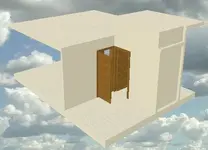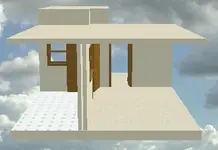C
You are using an out of date browser. It may not display this or other websites correctly.
You should upgrade or use an alternative browser.
You should upgrade or use an alternative browser.
C
chippyd
New member
Michael Jones
New member
Is this new construction? If so, all of your walls are parallel. Thats a big no no.
Standing waves will be a major problem.
Here's a design I worked out with help from John and a host of other Home Rec'rs on this BBS.
https://homerecording.com/bbs/attachment.php?postid=559296
Notice how the Drum, Vocal and Control Room have no parallel Walls.
Even the live room eliminates parallel-ism to a degree.
This studio is currently under construction too.
Standing waves will be a major problem.
Here's a design I worked out with help from John and a host of other Home Rec'rs on this BBS.
https://homerecording.com/bbs/attachment.php?postid=559296
Notice how the Drum, Vocal and Control Room have no parallel Walls.
Even the live room eliminates parallel-ism to a degree.
This studio is currently under construction too.
C
chippyd
New member
C
chippyd
New member
Michael Jones said:Is this new construction? If so, all of your walls are parallel. Thats a big no no.
Standing waves will be a major problem.
only the 4 rooms will be new.
this is one problem I have that I feel I can't do much about as the size of the site is only 22' by 17' and I find if i try and make it not parallel I wast too much space.
Will room treatment sort this out?
control room will be 14' by 10'
C
chippyd
New member
Let's say I have to go with the above layout.
What would be the best room treatment to make the control room sound ok?
I am talking D.I.Y. here and not that expensive foam stuff.
Unfortunately the room labels didn’t show up in the design plan.
The control room is bottom left, 14’8’’x 10’
with a vocal room above top left. 12’7’’x 5’8’’
Top right is a drum room 9’8’’x 9’5’’
Bottom right is the entrance and coffee making area 8’x 8’6’’
Daz
What would be the best room treatment to make the control room sound ok?
I am talking D.I.Y. here and not that expensive foam stuff.
Unfortunately the room labels didn’t show up in the design plan.
The control room is bottom left, 14’8’’x 10’
with a vocal room above top left. 12’7’’x 5’8’’
Top right is a drum room 9’8’’x 9’5’’
Bottom right is the entrance and coffee making area 8’x 8’6’’
Daz
DeadPoet
carpe diem
sorry to hijack the thread, but Michael, why is everybody repeating that parallel walls are a big no-no ???
If you design a studio, the maths for it are waaaay easier with rectangular walls and you maximize space usage too... If your dimensions are good so will the room be.
chippyd: bass traps are easiest with some 703 or similar semi-rigid fibreglass. Just stack them in a corner, floor to ceiling. the bigger the triangle you create the lower the lowest frequency absorbed will be.
another option is Ethan's panel absorbers.
Next: find first reflections with the mirror trick and try to have a diffuse back wall. This is for the control room off course.
Herwig
If you design a studio, the maths for it are waaaay easier with rectangular walls and you maximize space usage too... If your dimensions are good so will the room be.
chippyd: bass traps are easiest with some 703 or similar semi-rigid fibreglass. Just stack them in a corner, floor to ceiling. the bigger the triangle you create the lower the lowest frequency absorbed will be.
another option is Ethan's panel absorbers.
Next: find first reflections with the mirror trick and try to have a diffuse back wall. This is for the control room off course.
Herwig
Michael Jones
New member
Well, it's just the concensus of many studio design professionals that parallel walls aren't ideal for a studio.DeadPoet said:sorry to hijack the thread, but Michael, why is everybody repeating that parallel walls are a big no-no ???
If you design a studio, the maths for it are waaaay easier with rectangular walls and you maximize space usage too... If your dimensions are good so will the room be.
Herwig
From what I understand, the biggest reason for this is:
Parallel walls create standing waves. That is, the sound waves bounce directly off of one wall, and then interefere with sound waves comming from the source as the reflected wave heads directly back to the source. When this happens, some frequencies are cancelled out and others are boosted. This doesn't give an accurate representation of the music or sound being recorded. Angled walls, because reflected sound doesn't bounce directly back, eliminates this phenomena.
As far as the math goes, I have to disagree. Its just as easy to measure and cut a 12 degree angle as it is to measure and cut a 90 degree angle. Likewise its as easy to measure and cut a dimension of 6'-5 11/16" as it is to measure and cut a dimension of 6'-6".
While it is true that some space is lost, in proper studio design, the loss usually comes from implementing air space between the walls, rather than from angled walls. A good design will make use of most areas, and minimize the lost or un-usable area.
The net loss of say 3% - 5% of total floor space is a small price to pay for proper room acoustics and added isolation.
No one says you HAVE to have angled walls, its just a prefered method for optimal room acoustics.
C
charoo
New member
hey jones!
you must be aware with me, its' again a stupid charoo !
Well how can we calculate and angle our walls, i mean if i have to make my each parellel walls 6 degree angled, how i can do that? Moreover how i identify that my wall is accurately 6 degree angled.
luv
charoo
you must be aware with me, its' again a stupid charoo !
Well how can we calculate and angle our walls, i mean if i have to make my each parellel walls 6 degree angled, how i can do that? Moreover how i identify that my wall is accurately 6 degree angled.
luv
charoo
DeadPoet
carpe diem
Michael - I made a new thread on this...
Michael Jones
New member
Re: hey jones!
Then to lay out the drawing dimensions on the slab, you have to locate 2 points, one for each wall, usually from a common corner.
Then you use what is known as 2 taping or a distance-distance intersection. The length of each wall is the distance-distance, and those 2 dimensions will intersect at ONLY ONE PLACE on the slab.
Put down a mark there, and snap a chalk-line from that point to the first point you located.
That gives you a perfect 6 degree, or what ever angle you called for, in the drawing transfered to the slab.
The chalk line gives you the line of the wall.
It's really VERY simple, and incredibly accurate.
These days, we usually draw a floor plan up in cad. Dimension the drawing properly.charoo said:you must be aware with me, its' again a stupid charoo !
Well how can we calculate and angle our walls, i mean if i have to make my each parellel walls 6 degree angled, how i can do that? Moreover how i identify that my wall is accurately 6 degree angled.
Then to lay out the drawing dimensions on the slab, you have to locate 2 points, one for each wall, usually from a common corner.
Then you use what is known as 2 taping or a distance-distance intersection. The length of each wall is the distance-distance, and those 2 dimensions will intersect at ONLY ONE PLACE on the slab.
Put down a mark there, and snap a chalk-line from that point to the first point you located.
That gives you a perfect 6 degree, or what ever angle you called for, in the drawing transfered to the slab.
The chalk line gives you the line of the wall.
It's really VERY simple, and incredibly accurate.
Michael Jones
New member
Attached is a step by step method for laying out angled walls using the 2 tape method I spoke of above.
Again, in geometry, this is known as a distance-distance intersection. In the drawing, the green lines reprresent the angled walls, and the red line represent the tape measures.
(Note: The dimensions are hypothetical and don't constitute a 6 degree wall. But the method will work for ANY angle.)
Again, in geometry, this is known as a distance-distance intersection. In the drawing, the green lines reprresent the angled walls, and the red line represent the tape measures.
(Note: The dimensions are hypothetical and don't constitute a 6 degree wall. But the method will work for ANY angle.)
Attachments
C
chippyd
New member
C
chippyd
New member
the height of the control room will be 8 feet high, I have room to go up to around 12 feet. I know I can not go 10 feet on the hight because of standing waves but will 8 feet be ok or is there a different and better size to go here?
Last edited:
C
chippyd
New member
I guess if no one sees it as a problem I will go 8 feet tall on the control room.
Michael Jones
New member
Why not extend the angled control room wall, the one with the window in it, all the way to the existing wall. Then use that space created by the angle for a mic storage closet.
You could also parallel the live room wall, the one with the window in it, with the extended control room wall, just untill it gets past the window.
Add a couple of more diffusers on the other side of the control room (where you have 3 now) .
Add some bass traps and diffusers in the live room, and you're off to a good start.
You could also parallel the live room wall, the one with the window in it, with the extended control room wall, just untill it gets past the window.
Add a couple of more diffusers on the other side of the control room (where you have 3 now) .
Add some bass traps and diffusers in the live room, and you're off to a good start.
C
chippyd
New member
thanks 
yes I was thinking about that but I wanted to get as much room as I could for the near fields to be away from the side walls

yes I was thinking about that but I wanted to get as much room as I could for the near fields to be away from the side walls
Michael Jones
New member
C
chippyd
New member
thinking about angled walls how about this, anyone.....
this one has the doors http://www.chippyd.com/dw/plan/1c4d.WMF
this one has the doors http://www.chippyd.com/dw/plan/1c4d.WMF



